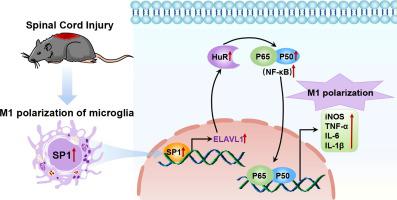当前位置:
X-MOL 学术
›
Neuroscience
›
论文详情
Our official English website, www.x-mol.net, welcomes your feedback! (Note: you will need to create a separate account there.)
Sp1 Regulates the M1 Polarization of Microglia Through the HuR/NF-κB Axis after Spinal Cord Injury
Neuroscience ( IF 3.3 ) Pub Date : 2024-02-21 , DOI: 10.1016/j.neuroscience.2024.02.014 Hangyu Guo , Mingyu Du , Yang Yang , Xin Lin , Yufu Wang , Helin Li , Jiyu Ren , Wenbo Xu , Jinglong Yan , Nanxiang Wang
Neuroscience ( IF 3.3 ) Pub Date : 2024-02-21 , DOI: 10.1016/j.neuroscience.2024.02.014 Hangyu Guo , Mingyu Du , Yang Yang , Xin Lin , Yufu Wang , Helin Li , Jiyu Ren , Wenbo Xu , Jinglong Yan , Nanxiang Wang

|
The M1 polarization of microglia, followed by the production of pro-inflammatory mediators, hinders functional recovery after spinal cord injury (SCI). Our previous study has illuminated that specificity protein 1 (Sp1) expression is increased following SCI, whereas the function and regulatory mechanism of Sp1 during M1 polarization of microglia following SCI remain unknown. RNA binding protein, HuR, has been shown to be up-regulated in the injured spinal cord through analysis of the GEO database. Further investigation using Chip-Atlas data suggests a binding between Sp1 and HuR. Emerging evidence indicates that HuR plays a pivotal role in neuroinflammation after SCI. In this research, Sp1 and HuR levels in mice with SCI and BV2 cells treated with lipopolysaccharide (LPS) was determined by using quantitative real-time polymerase chain reaction and Western blotting techniques. A series of assays were performed to investigate the function of Sp1 during M1 polarization of microglia. The association between Sp1 and its target gene HuR was confirmed through gene transfection and luciferase reporter assay. Enhanced expression of HuR was observed in both SCI mice and LPS-treated BV2 cells, while Sp1 knockdown restrained M1 polarization of microglia and its associated inflammation by inhibiting the NF-κB signaling pathway. Silencing Sp1 also suppressed microglia activation and its mediated inflammatory response, which could be reversed by overexpression of HuR. In conclusion, silencing Sp1 restrains M1 polarization of microglia through the HuR/NF-κB axis, leading to neuroprotection, and thus promotes functional restoration following SCI.
中文翻译:

脊髓损伤后 Sp1 通过 HuR/NF-κB 轴调节小胶质细胞的 M1 极化
小胶质细胞的 M1 极化以及促炎介质的产生阻碍了脊髓损伤 (SCI) 后的功能恢复。我们之前的研究表明,SCI 后特异性蛋白 1 (Sp1) 表达增加,但 SCI 后小胶质细胞 M1 极化过程中 Sp1 的功能和调节机制仍不清楚。通过对 GEO 数据库的分析,RNA 结合蛋白 HuR 已被证明在受伤的脊髓中表达上调。使用 Chip-Atlas 数据进行的进一步研究表明 Sp1 和 HuR 之间存在结合。新的证据表明 HuR 在 SCI 后的神经炎症中发挥着关键作用。在这项研究中,通过使用定量实时聚合酶链反应和蛋白质印迹技术测定了经脂多糖(LPS)处理的 SCI 和 BV2 细胞小鼠中 Sp1 和 HuR 的水平。进行了一系列测定来研究 Sp1 在小胶质细胞 M1 极化过程中的功能。通过基因转染和荧光素酶报告基因检测证实了 Sp1 与其靶基因 HuR 之间的关联。在 SCI 小鼠和 LPS 处理的 BV2 细胞中均观察到 HuR 表达增强,而 Sp1 敲低则通过抑制 NF-κB 信号通路抑制小胶质细胞的 M1 极化及其相关炎症。沉默 Sp1 还可以抑制小胶质细胞的激活及其介导的炎症反应,而这种作用可以通过 HuR 的过度表达来逆转。总之,沉默 Sp1 通过 HuR/NF-κB 轴抑制小胶质细胞的 M1 极化,从而产生神经保护作用,从而促进 SCI 后的功能恢复。
更新日期:2024-02-21
中文翻译:

脊髓损伤后 Sp1 通过 HuR/NF-κB 轴调节小胶质细胞的 M1 极化
小胶质细胞的 M1 极化以及促炎介质的产生阻碍了脊髓损伤 (SCI) 后的功能恢复。我们之前的研究表明,SCI 后特异性蛋白 1 (Sp1) 表达增加,但 SCI 后小胶质细胞 M1 极化过程中 Sp1 的功能和调节机制仍不清楚。通过对 GEO 数据库的分析,RNA 结合蛋白 HuR 已被证明在受伤的脊髓中表达上调。使用 Chip-Atlas 数据进行的进一步研究表明 Sp1 和 HuR 之间存在结合。新的证据表明 HuR 在 SCI 后的神经炎症中发挥着关键作用。在这项研究中,通过使用定量实时聚合酶链反应和蛋白质印迹技术测定了经脂多糖(LPS)处理的 SCI 和 BV2 细胞小鼠中 Sp1 和 HuR 的水平。进行了一系列测定来研究 Sp1 在小胶质细胞 M1 极化过程中的功能。通过基因转染和荧光素酶报告基因检测证实了 Sp1 与其靶基因 HuR 之间的关联。在 SCI 小鼠和 LPS 处理的 BV2 细胞中均观察到 HuR 表达增强,而 Sp1 敲低则通过抑制 NF-κB 信号通路抑制小胶质细胞的 M1 极化及其相关炎症。沉默 Sp1 还可以抑制小胶质细胞的激活及其介导的炎症反应,而这种作用可以通过 HuR 的过度表达来逆转。总之,沉默 Sp1 通过 HuR/NF-κB 轴抑制小胶质细胞的 M1 极化,从而产生神经保护作用,从而促进 SCI 后的功能恢复。






























 京公网安备 11010802027423号
京公网安备 11010802027423号